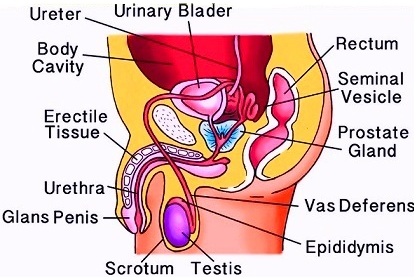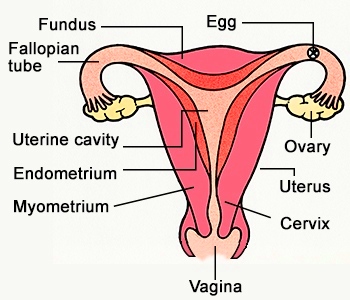Revision Notes on Human Reproduction
 (1) Reproduction is the formation of new individuals of their own kind by living organisms.
(1) Reproduction is the formation of new individuals of their own kind by living organisms.
(2) The Male Reproductive System consists of:
(a) Primary sex organs i.e. a pair of testes suspended in a scrotum.
Secondary sorgans i.e. a pair of ducts each differentiated into an epididymis, a vas deferens and an ejaculatory duct.
(c) A male urethra passing through an erectile penis.
 (d) Three types of Glands - a pair of seminal vesicles, a prostate gland and a pair of Cowper’s glands.
(d) Three types of Glands - a pair of seminal vesicles, a prostate gland and a pair of Cowper’s glands.
(3) The Female Reproductive system consists of:
(a) Primary sex organ i.e. a pair of ovaries
(b) Secondary sex organs i.e. a pair of fallopian tubes (oviducts) , a uterus (womb), a vagina.
(4)Ovaries produce female gametes called ova.
Phases of embryonic development
Embryonic development involves following dynamic changes and identifiable process.
(1) Gametogenesis : It involve the formation of haploid sex cells or gametes called sperms and ova from diploid primary germ cells called gametogonia present in the reproductive organs called gonads (testes and ovary). It is of two types;
(i) Spermatogenesis: Formation of sperm.
(ii) Oogenesis : Formation of ova
(2) Fertilization: It involves the fusion of haploid male and female gametes to form diploid zygote. The fusion of gametic pronuclei is called Karyogamy while the mixing of two sets of chromosomes of two gametes is called amphimixis.
(3) Cleavage: It includes the rapid mitotic division of the zygote to form a single layered hollow spherical larva called blastula and its formation is called blastulation.
(4) Implantation: The process of attachment of the blastocyst (mammalian blastula) on the endometrium of the uterus is called implantation.
(5) Gastrulation: It includes the mass and orderly migration of the organ specific areas from the surface of blastula to their predetermined position which finally produces a 3 layered gastrula larva. It is with 3 primary layers.
(6) Organogenesis: It includes the formation of specific organs system from three primary germ layers of gastrula and also includes the morphogenesis and differentiation.
Fertilization
(1) Definition: Fusion of a haploid male gamete (spermatozoon) and a haploid female gamete (ovum) to form a diploid cell, the zygote, is called fertilization or syngamy.
(2) Site of fertilization: Fertilization in human female is internal as in other mammals. It takes place usually in the ampulla of the fallopian tube.
(3) Steps of fertilization
(i) Approach of sperm to ovum:
(a) Male discharges semen (3.5 ml) in the female’s vagina close to the cervix during coitus. This is called ejaculation or insemination. This ejaculation contains as many as 400 million sperms but only about 100 sperms reach the fallopian tube because many sperms are either killed by the acidity of female genital tract or engulfed by the phagocytes of the vaginal epithelium.
(b) The sperm swim in the seminal fluid at the rate of 1-4 mm per minute by the aspiratory action of the uterus and peristaltic movement of the fallopian tube.
(c) Capacitation is the phenomenon of physiological maturation of sperms by breaking of acrosome membrane inside the female genital tract. It takes about 5-6 hours.
(d) Ovum is released on the 14th day of menestrual cycle trapped by the fimbriae of the ampulla of fallopian tube and move towards the uterus by peristalsis and ciliary action.
(e) At the time of ovulation, egg is at secondary oocyte stage.
(f) Fertilizability of human sperm in the female genital tract is of 12 to 24 hours while its survival value is upto 3 days and of ovum is only 24 hours though it can live for about 72 hours.
 (ii) Penetration of sperm:
(ii) Penetration of sperm:
(a) The ovum secretes a chemical substance called fertilizin, which has a number of spermophillic sites on its surface where the sperm of species specific type can be bound by their antifertilizin site.
(b) This fertilizin-antifertilizin interaction causes agglutination (sticking together) of egg and sperm.
(c) The sperm generally comes in contact with ovum in the animal pole (side of ovum with excentric nucleus) while the opposite side of ovum is called vegetal pole.
(d) Ovulation in the human female occurs at secondary oocyte stage in which meiosis-I have been completed and first polar body has been released but second maturation is yet to complete.
(e) Penetration of sperm is a chemical mechanism.
(f) In this acrosome of sperm undergoes acrosomal reaction and releases certain sperm lysins which dissolve the egg envelopes locally and make the path for the penetration of sperm.
(g) These sperm lysins contain a lysing enzyme hyaluronidase which dissolves the hyaluronic acid polymers in the intercellular spaces which holds the granulosa cells of corona radiata together; corona penetrating enzyme (that dissolves the corona radiata) and acrosin (which dissolves the zona pellucida). Then it dissolves the zona pellucida.
(h) Only sperm nucleus and middle piece enter the ovum. The tail is lost.
(iii) Cortical reaction:
(a) Immediately after the entry of a sperm into the egg, the later shows a cortical reaction to check the entry of more sperms.
(b) In this reaction, the cortical granules present beneath the egg’s plasma membrane release chemical substance between the ooplasm and the plasma membrane (vitelline membrane).
(c) These substances raise the vitelline membrane above the egg surface. The elevated vitelline membrane is called fertilization membrane.
(d) The increased space between the ooplasm and the fertilization membrane and the chemical present in it effectively check the entry of other sperm.
(e) If polyspermy occurs, that is more than one sperm enter the secondary oocyte, the resulting cell has too much genetic material to develop normally.
 (iv) Fusion of gametic nuclei:
(iv) Fusion of gametic nuclei:
(a) Entrance of spermatozoon serves to acts as stimulus which causes the second maturation division.
(b) As the head and middle piece of the sperm advance into the egg, those parts rotate through an angle of 180° so that the mitochondria and proximal centriole of the associated middle piece assume the leading position.
(c) Beside this rotation, the chromatin itself starts swelling by absorbing fluid from the surrounding cytoplasm and becomes vesicular.
(d) It is now called male pronucleus. This direction of movement of male pronucleus is called penetration path.
(e) The centriole brought in by the spermatozoon subdivides into two and as achromatic spindle is established in the center of the active cytoplasm.
(f) With the production of the second polar body, the egg nucleus or female pronucleus is ready for union with the male pronucleus provided by the sperm head.
(g) The male pronucleus which has been advancing the penetration path, now moves directly toward the female pronucleus. This in many cases involves a slight change in the course of sperm.
(h) In such cases, the later portion of its course is called the copulation path.
(i) The centrioles of middle piece of sperm form a spindle.
(j) The nuclear membrane of the gametic nuclei degenerates and two sets of chromosomes initially lie on two poles of the spindle but later these sets of chromosomes mix up and the process is called amphimixis.
(k) The fertilized egg is now called zygote and the zygote nucleus is called synkaryon.
Significance of fertilization
(a) It provides stimulus for the egg to complete its maturation.
(b) It activates the ovum to develop into a new individual by repeated mitotic division.
(c) Fertilization restores the diploid number of chromosomes (46 in man) in the zygote by adding male’s haploid set of chromosomes.
(d) It makes the egg more active metabolically.
(e) It combines the character of two parents and introduces variations. So help in evolution.
(f) Sex chromosomes of sperm is either X or Y and helps in sex determination.
(g) Fertilization membrane formed after sperm entry, checks the entry of additional sperms.
(h) Copulation path sets the axis of division.
Menstrual Cycle
(1) Menstruation occurs in human, apes and old world monkeys.
(2) Menstruation is bleeding from the uterus of adult females at intervals of one lunar month.
(3) Beginning of menstruation or first menstruation is called menarche.
(4) The beginning of menstruation varies. It usually occurs between 12 and 15 years.
(5) The cycle of events starting from one menstruation till the next one is called Menstrual Cycle.
(6) In human females, menstruation is repeated at an average interval of about 28/29 days.
(7) One ovum is released (ovulation) during the middle of each menstrual cycle.
(8) It is regulated by certain hormones, some of which are secreted by the pituitary gland.
(9) The pituitary gland is stimulated by releasing factors produced in the hypothalamus.
(10) The hormones produced by the pituitary gland influence the ovaries. The hormones secreted by the ovaries affect the walls of the uterus.
Phases of Menstrual Cycle
The menstrual cycle consists of following four phases:
(1) Menstrual Phase:
(i) In a 28 days menstrual cycle,the menses takes place on cycle days 3-5.
(ii) The production of LH from the anterior lobe of the pituitary gland is reduced.
(iii) The withdrawal of this hormone causes degeneration of the corpus luteum and, therefore progestrone production is reduced.
(iv) Production of oestrogen is also reduced in this phase.
(v) The endometrium of uterus breaks down & menstruation begins.
(vi) The cells of endometrium secretions, blood & unfertilised ovum constitutes the menstrual flow.
(2) Follicular Phase:
(i) This phase usually includes cycle days 6-13 or 14 in a 28 days cycle.
(ii) The follicle stimulating hormone (FSH) secreted by the anterior lobe of the pituitary gland stimulates the ovarian follicle to secrete oestrogens.
(iii) Oestrogen stimulates the proliferation of the endometrium of the uterine wall.
(iv) The endometrium becomes thicker by rapid cell multiplication and this is accompanied by an increase in uterine glands & blood vessels.

(3) Ovulatory Phase:
(i) Both LH & FSH attain a peak level in the middle of cycle (about 14th day).
(ii) Oestrogen concentration in blood increases.
(iii) Rapid secretion of LH induces rupturing of graffian follicle and thereby the release of ovum.
(iv) In fact LH causes ovulation.
(4) Luteal Phase:
(i) Includes cycle days 15 to 28.
(ii) Corpus luteum secretes progestrone.
(iii) Endometrium thickens.
(iv) Uterine glands become secretory.
Hormonal Control of MC
(i) FSH stimulates the ovarian follicles to produce oestrogens.
(ii) LH stimulates corpus luteum to secrete progestrone.
(iii) Menstrual phase is caused by the increased production of oestrogens.
(iv) LH causes ovulation
(v) Proliferative phase is caused by the increased production of oestrogens.
(vi) Secretory phase is caused by increased production of progestrone.
View courses by askIITians


Design classes One-on-One in your own way with Top IITians/Medical Professionals
Click Here Know More

Complete Self Study Package designed by Industry Leading Experts
Click Here Know More

Live 1-1 coding classes to unleash the Creator in your Child
Click Here Know More

a Complete All-in-One Study package Fully Loaded inside a Tablet!
Click Here Know MoreAsk a Doubt
Get your questions answered by the expert for free